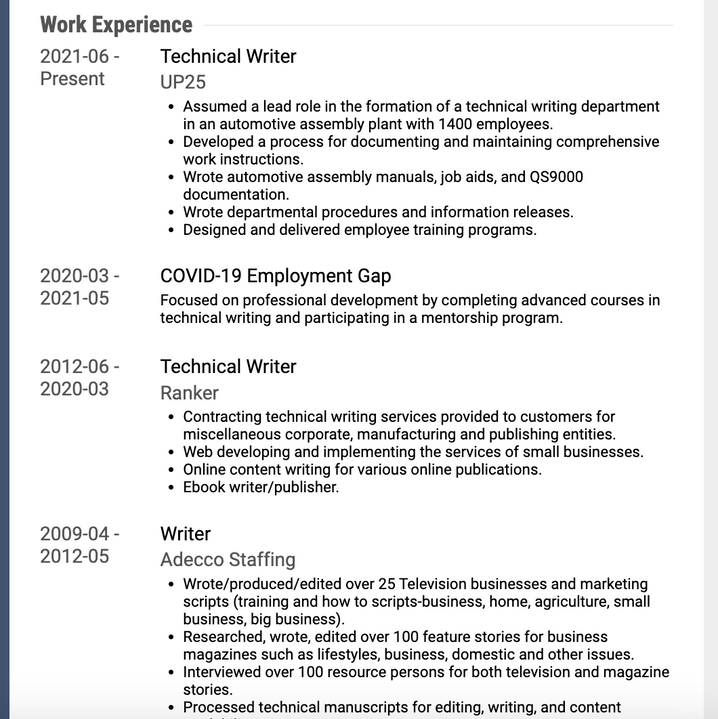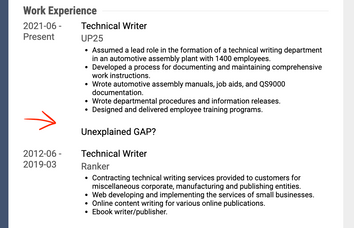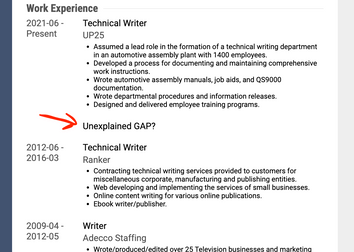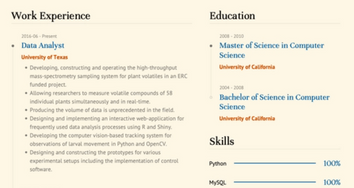
How To Explain COVID Gap On Resume - Pandemic Gap, Pandemic Sabbatical On Resume

Navigating how to explain COVID gap on a resume can be challenging, but it's a common issue many job seekers face today. Whether you experienced job loss, a career break, or other disruptions, it's important to address this gap professionally.
In this guide, we'll dive into specific scenarios, showing you exactly where and what to write on your resume to effectively explain your COVID gap, ensuring your application stands out positively.
How to Explain the COVID Gap on Your Resume
Addressing a gap in your resume due to COVID-19 can be straightforward if you focus on transparency and positive outcomes. Here’s how you can explain it:
- Laid off due to company downsizing: "The pandemic led to significant downsizing in my company, resulting in my role being eliminated. During this time, I focused on upskilling through online courses to stay updated with industry trends."
- Career shift or industry change: "The pandemic prompted me to reassess my career goals. I used this period to transition into [new industry/role], acquiring relevant skills through self-study and certification programs."
- Personal or family health issues: "I took time off during the pandemic to care for a family member dealing with health challenges. Once the situation stabilized, I resumed my career search, now more committed and resilient."
- Freelancing or gig work: "During the COVID gap, I engaged in freelance work/projects in [industry], which helped me maintain my professional skills and build a portfolio of work."
- Volunteering or community involvement: "With more time on my hands, I chose to contribute to my community by volunteering with [organization]. This experience enhanced my teamwork and problem-solving skills."
- Personal development or education: "I used the COVID period as an opportunity for personal development, completing [specific courses, certifications] that have made me a stronger candidate in my field."
- Starting a side business or project: "During the pandemic, I launched a side project/business in [industry/field], which allowed me to develop entrepreneurial skills and manage various aspects of a business."
- Relocation or adapting to new circumstances: "The pandemic required me to relocate and adapt to a new environment. During this time, I focused on networking and understanding the local job market while exploring new career opportunities."
- Taking a break for mental health: "I took a deliberate break during the pandemic to focus on my mental health and well-being. This period of self-care has left me more motivated and prepared to contribute effectively in my next role."
- Homeschooling or caring for children: "With schools closed, I took on the responsibility of homeschooling my children. This experience honed my organizational and time-management skills, which I’m eager to bring to my professional life."
- Exploring creative endeavors: "I used the downtime during the pandemic to explore creative pursuits like [writing, art, music], which not only kept me engaged but also enhanced my creativity and problem-solving abilities."
These explanations show how you stayed proactive, making them effective ways to address any COVID-related employment gaps.
Where to Explain COVID Gap on Resume
When it comes to explaining a COVID-related gap on your resume, the most effective place to address it is either in your work experience section or in a brief section dedicated to explaining career gaps.
In your work experience section, you can add a short description under the relevant timeline, directly addressing the gap. For instance, after listing your previous job, include a line such as, "March 2020 - September 2020: Career Break due to COVID-19," followed by a brief explanation of what you did during that time.
Alternatively, you could create a separate section titled "Career Break" or "COVID-19 Impact," where you can provide a concise narrative about the gap. This method allows you to control the narrative and highlight any positive actions you took during the period.
Explaining the COVID Gap in Each Work Experience Section of Your Resume
- Work Experience Section: If your gap falls between jobs, you can integrate the explanation directly into your employment history. For example:
- XYZ Corporation, Marketing Manager (July 2018 - March 2020)
- Career Break due to COVID-19 (March 2020 - September 2020): Focused on upskilling through online courses in digital marketing and data analytics.
Explaining the COVID Gap on a Dedicated Career Gap Section of Your Resume
- Dedicated Career Gap Section: If the gap is significant or spans several months, a dedicated section can be more appropriate. Example:
- Career Break (March 2020 - September 2021): The COVID-19 pandemic led to a temporary pause in my career. During this time, I engaged in freelance projects, completed certifications in project management, and volunteered with local non-profits.
Explaining the COVID Gap on a Cover Letter Instead of Resume
- Cover Letter: While the resume addresses the gap briefly, your cover letter can offer more context. You can mention how the break influenced your professional growth and why you are now ready to re-enter the workforce.
These strategies not only clarify the reason for your employment gap but also demonstrate your proactive approach during that period, turning a potential red flag into a positive talking point.
How to Explain COVID Sabbatical on Your Resume
When explaining a COVID sabbatical on your resume, keep it simple and clear. You can mention the sabbatical in your work experience section or create a separate section for it. Focus on how you used this time to grow personally or professionally.
In the work experience section, you can include a brief note like "COVID-19 Sabbatical (April 2020 - December 2020)" and add a short explanation of what you did during that time. If you choose to create a separate section, you can title it "Sabbatical" and provide a little more detail about how you used the time for rest, reflection, or gaining new skills. This helps employers see that you made the most of your time off and are ready to bring fresh energy and insights to your next role.
Examples of How to List a COVID Sabbatical on Work Experience Section
- COVID-19 Sabbatical (April 2020 - December 2020): Focused on personal development through online courses in data analysis and digital marketing.
Examples of How to List a COVID Sabbatical on a Dedicated Sabbatical Section
- Sabbatical (April 2020 - December 2020): Took a break during the pandemic to recharge and upskill, completing certifications in project management and volunteering with a local charity.
These examples show how to frame your sabbatical positively, highlighting your proactive approach during the time off.
How to Explain the COVID Gap on Your Resume from 2020
When explaining a COVID gap on your resume from 2020, it's important to be honest and straightforward. You can mention the gap briefly in your work experience section or include a separate note to address it. Focus on what you did during that time, whether it was personal development, caregiving, or any other productive activities.
In the work experience section, you might write something like "COVID-19 Employment Gap (March 2020 - December 2020)" and follow it with a short description of how you used the time. If the gap was significant, you could add a brief "Career Gap" section, where you explain the situation and emphasize any skills or experiences gained during that period. This helps to reassure employers that you stayed engaged and are prepared to return to work with renewed focus.
Examples of How to Address the 2020 COVID Gap
-
Work Experience Section:
- COVID-19 Employment Gap (March 2020 - December 2020): Used this period to upskill with courses in digital marketing and engage in freelance writing projects.
-
Dedicated Career Gap Section:
- Career Gap (March 2020 - December 2020): Took time off due to the pandemic's impact. Focused on learning new skills, including completing an online certification in data science.
These examples show how to clearly and positively address the 2020 COVID gap on your resume, turning a potential concern into a demonstration of resilience and proactive growth.
How to Explain the COVID Gap on Your Resume from 2021
Explaining a COVID gap on your resume from 2021 requires a clear and concise approach. You can address the gap within your work experience section or include a separate note specifically for it. The key is to highlight how you stayed productive or what positive actions you took during that time.
In your work experience section, you might include a line such as "COVID-19 Employment Gap (January 2021 - September 2021)" with a brief explanation of how you utilized the period. Alternatively, if the gap was significant, consider adding a "Career Gap" section where you can provide context and detail any skills, projects, or personal developments you pursued. This approach reassures employers that you remained proactive and focused on growth, even during challenging times.
Examples of How to Address the 2021 COVID Gap in the Work Experience Section of Your Resume
- COVID-19 Employment Gap (January 2021 - September 2021): Focused on professional development by completing advanced courses in web development and participating in a mentorship program.
Examples of How to Address the 2021 COVID Gap in a Dedicated Career Gap Section of Your Resume
- Career Gap (January 2021 - September 2021): Took a break due to pandemic-related circumstances. During this time, I engaged in volunteer work, learned new skills through online courses, and prepared for my next career step.
These examples illustrate how to effectively explain a 2021 COVID gap on your resume, demonstrating your resilience and commitment to continuous improvement.
How to Explain a COVID Gap on a Resume Due to Lack of Remote Work Opportunities
If your industry or role didn't support remote work during the pandemic, explain that the lack of remote opportunities led to a temporary employment gap. Highlight how you used this time to acquire new skills or explore different career paths that could offer more flexibility in the future.
How to Explain a COVID Gap on a Resume from Being Furloughed by Your Employer
If you were furloughed during the pandemic, simply state that your employer had to temporarily reduce the workforce due to COVID-19 impacts. Emphasize how you remained proactive during this period by engaging in professional development or other productive activities.
How to Explain a COVID Gap on a Resume Due to Delayed Hiring Processes
Hiring processes across many industries were delayed due to the uncertainty caused by COVID-19. Mention that the prolonged hiring timelines led to a gap, but you stayed active by pursuing freelance work, certifications, or other growth opportunities while waiting for the right role.
How to Explain a COVID Gap on a Resume After a Temporary Business Shut Down
If the company you worked for temporarily shut down due to the pandemic, explain that the business closure led to a brief gap in your employment. Highlight any steps you took to stay engaged, such as online learning, volunteering, or preparing for your return to the workforce.
How to Explain a COVID Gap on a Resume from Working in an Industry Severely Impacted by COVID-19
If you were in an industry that was severely affected by COVID-19, like hospitality or tourism, explain that the industry-wide downturn led to a gap in your employment. Focus on how you adapted by either exploring new fields or enhancing your skill set to remain competitive.
How to Explain a COVID Gap on a Resume Due to Travel Restrictions
If your job involved travel that was halted by COVID-19 restrictions, explain that these limitations led to an unavoidable employment gap. Share how you used the time to pivot your skills to more location-independent roles or invested in professional development.
How to Explain a COVID Gap on a Resume Due to Delayed Graduation or Education
If COVID-19 delayed your graduation or educational pursuits, mention that the pandemic extended your academic timeline, leading to a gap before entering or re-entering the workforce. Highlight how you utilized this period for internships, online courses, or relevant projects.
How to Explain a COVID Gap on a Resume After Transitioning Out of Hospitality or Retail
If you transitioned out of hospitality or retail due to the pandemic, explain that you took time to reassess your career goals and explore new opportunities. Focus on any training, certifications, or internships you pursued to facilitate this career change.
How to Explain a COVID Gap on a Resume After a Forced Career Change Due to COVID-19
If the pandemic forced you to change careers, explain that the shift required time to acquire new skills or credentials, leading to an employment gap. Emphasize your adaptability and the proactive steps you took to successfully transition into your new field.
- How to Explain the COVID Gap on Your Resume
- Where to Explain COVID Gap on Resume
- How to Explain COVID Sabbatical on Your Resume
- How to Explain the COVID Gap on Your Resume from 2020
- How to Explain the COVID Gap on Your Resume from 2021
- How to Explain a COVID Gap on a Resume Due to Lack of Remote Work Opportunities
- How to Explain a COVID Gap on a Resume from Being Furloughed by Your Employer
- How to Explain a COVID Gap on a Resume Due to Delayed Hiring Processes
- How to Explain a COVID Gap on a Resume After a Temporary Business Shut Down
- How to Explain a COVID Gap on a Resume from Working in an Industry Severely Impacted by COVID-19
- How to Explain a COVID Gap on a Resume Due to Travel Restrictions
- How to Explain a COVID Gap on a Resume Due to Delayed Graduation or Education
- How to Explain a COVID Gap on a Resume After Transitioning Out of Hospitality or Retail
- How to Explain a COVID Gap on a Resume After a Forced Career Change Due to COVID-19

Written By
Madison Norton
VP Marketing & Resume Expert
Madison is the VP Marketing and General Manager at VisualCV. He's a seasoned marketing leader, resume writing and career marketing expert and now helping people grow their own career marketing strategies to build a career they love.

Learn everything you need to know about how to explain a two-year career gap on your resume, with examples for situations like travel, family care, education, and career changes.
August 10, 2024
Read Post

VP Marketing & Resume Expert

Learn how to effectively explain a five-year career gap on your resume, whether it's due to travel, caregiving, education, or other reasons. Use these tips to turn your gap into a strength.
August 15, 2024
Read Post

VP Marketing & Resume Expert

Learn how to write a targeted resume that matches job descriptions with precision. Discover tips on customizing your resume using keywords, optimizing for ATS, and highlighting relevant skills and experiences to improve your job application success.
July 19, 2024
Read Post

VP Marketing & Resume Expert
Copyright ©2025 Workstory Inc.